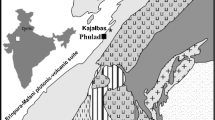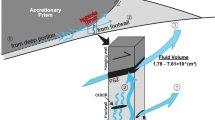Abstract
A retrograde sequence of fluid-controlled, low-temperature mineral reactions has been preserved along an east-west striking, dextral-oblique-slip fault in the uplifted Rhine Graben shoulder. This fault (the Schauenburg Fault, near Heidelberg), juxtaposes Permian rhyolite against Carboniferous (Variscan) granite and shows syn- or post-rift displacement of the north–south trending, eastern boundary fault of the rift basin. Both mineral texture and rock fabric indicate that the fault forms a site of high rock permeability and fluid flow, and records the exhumation and fluid-rock history of the rift shoulder since the Mesozoic. The reaction sequence and mineral compositions of the clay minerals within the cataclasite, and adjacent granite and rhyolite lithologies, document progressively decreasing fluid temperatures, with back-reactions of pure 2M1 illite to 1Md (R3) illite-smectite, and eventually smectite and kaolinite assemblages. Compositional variations are attributed to Tertiary to Recent fluid flushing of the fault zone associated with rift flank uplift, and with progressive dilution of the electrolyte-rich, acidic to neutral hydrothermal brines by down-flowing electrolyte-poor, meteoric waters.











Similar content being viewed by others
References
Abad I, Nieto F, Peacor DR, Velilla N (2003) Prograde and retrograde diagenetic and metamorphic evolution in metapelitic rocks of Sierra Espuna (Spain). Clay Miner 38:1–23
Abebe T (2000) Geological limitations of a geothermal system in a continental rift zone: example the Ethiopian rift valley. In: Proceedings World Geothermal Congress, Kyushu-Tohoku, Japan, May 28–June 10
Andrae A, Osann A (1893) Erläuterungen zur Geologie des Blattes Heidelberg. 5. Auflage von Hans Thürach (1995) Mitt Bad Geol L-Anst 2:345–388
Appelo CAJ, Postma D (1999) Geochemistry, groundwater and pollution. Balkema, Rotterdam, p 536
Aquilina L, Pauwels H, Genter A, Fouillac C (1997) Water-rock interaction processes in the Triassic sandstone and the granitic basement of the Rhine Graben: geochemical investigations of a geothermal reservoir. Geochim Cosmochim Acta 61:4281–4295
van Balen RT, Cloetingh SAPL (1993) Stress-induced fluid flow in rifted basins. In: Horbury AD, Robinson AG (eds) Diagenesis and basin development. American Association of Petroleum Geologists, Tulsa, Okalahoma, pp 87–98
Bartels J, Kühn M, Pape H, Clauser C (2000) A new aquifer simulation tool for coupled flow, heat transfer, multi-species transport and chemical water-rock-interaction. In: Proceedings World Geothermal Congress, Kyushu-Tohoku, Japan
Behr H-J, Horn EE, Frentzel-Beyme K, Reutel C (1987) Fluid inclusions characteristics of the Variscan and post-Variscan mineralizing fluids in the FRG. Chem Geol 61:273–285
Bender K (1995) Herkunft und Entstehung der Mineral-und Thermalwässer im nördlichen Schwarzwald. Heidelberger Geowissenschaftliche Abhandlungen: Band 85; Ruprecht-Karls-Universität Heidelberg, p 145
Bove DJ, Eberl DD, McKarty DK, Meeker GP (2002) Characterization and modeling of illite crystal particles and growth mechanisms in a zoned hydrothermal deposit, Lake City, Colorado. Am Mineral 87:1546–1556
Brindley GW, Brown G (eds) (1980) Crystal structures of clay minerals and their X-ray identification. Monograph 5: Mineralogical Society London, p 326
Brockamp O, Clauer N, Zuther M (2003) Authigenic sericite record of a fossil geothermal system: the Offenburg trough, central Black Forest, Germany. Int J Earth Sci 92:843–851
Carlé W (1958) Rezente und fossile Mineral- und Thermalwässer im Oberrheintalgraben und seiner weiteren Umgebung. Jber Mitt Oberrh Geol Ver 40:77–105
Carlé W (1975) Die Mineral- und Thermalwässer von Mitteleuropa. Wissenschaftliche Verlagsgesellschaft mbH, p 643
Clauer N, O’ Neil JR, Furlan S (1995) Clay minerals as record of temperature conditions and duration of thermal anomalies in the Paris Basin, France. Clay Miner 30:1–13
Clauser C, Griesshaber E, Neugebauer H (2002) Decoupled thermal and mantle helium anomalies: implications for the transport regime in continental rift zones. J Geophysical Res 107(B11):1-1–1-16
Dong H, Peacor DR, Freed RL (1997) Phase relations among smectite, R1 illite-smectite and illite. Am Mineral 82:379–391
Durst P, Vuataz FD (2000) Fluid-rock interactions in hot dry rock reservoirs. A review of the HDR sites and detailed investigations of the Soultz-sous-Forets system. In: Proceedings World Geothermal Congress 2000, Kyushu-Tohoku, Japan, May 28–June 10
Ehrenberg SN, Aagaard P, Wilson MJ, Fraser AR, Duthie DM (1992) Depth-dependent transformation of kaolinite to dickite in sandstones of the Norwegian continental shelf. The Mineralogical Society, pp 325–352
Evans JP (1990) Textures, deformation mechanisms and the role of fluids in the cataclastic deformation of granitic rocks. In: Knipe RJ, Rutter EH (eds) Deformation mechanisms, rheology and tectonics. Geological Society Special Publication 54:29–39
Frey M (1987) Very low-grade metamorphism of clastic sedimentary rocks. In: Frey M (eds) Low temperature metamorphism. Chapman and Hall, Blackie, pp 9–58
Gautschi A (2000) Hydrogeology of a fractured shale (Opalinus clay): Implications for deep geological disposal of radioactive wastes. Hydrogeol J 9:97–107
Grathoff GH, Moore DM (1996) Illite polytype quantification using WILDFIRE calculated X-ray diffraction patterns. Clays Clay Miner 44:834–842
Hess JC, Lippolt HJ (1996) Numerische Stratigraphie permokarbonischer Vulkanite Zentraleuropas. Geol Jb Hessen III: Odenwald 124:39–46
Hower J, Mowatt TC (1966) The mineralogy of illites and mixed-layer illite/montmorillo-nites. Am Mineral 51:825–854
Hunziker JC, Frey M, Clauer N, Dallmeyer RD, Friedrichsen H, Flehmig W, Hochstrasser K, Roggwiler P, Schwander H (1986) The evolution of illite to muscovite: mineralogical and isotopic data from the Glarus Alps, Switzerland. Contrib Mineral Petrol 92:157–180
Illies JH (1968) Graben tectonics as related to crust-mantle interaction. In: Illies JH, Mueller S (eds) Graben problems. International Upper Mantle Project, Scientific Report 27
Illies JH, Fuchs K (1974) Approaches to taphrogenesis. Inter-Union Commission on Geodynamics Scientific Report 8, Stuttgart
Inoue A, Meunier A, Beaufort D (2004) Illite-smectite mixed-layer minerals in felsic volcaniclastic rocks from drill cores Kakkonda Japan. Clays Clay Miner 52(1):66–84
Kim JW, Peacor DR, Tessier D, Elsass F (1995) A technique for maintaining texture and permanent expansion of smectite interlayers for TEM observations. Clays Clay Miner 43:51–57
Knipe RJ (1993) The influence of fault zone processes and diagenesis on fluid flow. In: Horbury AD, Robinson AG (eds) Diagenesis and basin development. Am Assoc Pet Geol Stud Geol 36:135–148
Lampe C, Person M, Nöth S, Ricken W (2001) Episodic fluid flow within continental rift basins: some insights from field data and mathematical models of the Rhine Graben. Geofluids I:42–52
Laubscher H (2001) Plate interactions at the southern end of the Rhine Graben. Tectonophysics 343(1–2):1–19
Lippolt HJ, Kirsch H, Plein E (1990) Karbonische und permische Vulkanite aus dem Untergrund des nördlichen Oberrheingrabens: Art, Altersbestimmung und Konsequenz. Jber Mitt Oberrhein Geol Ver 2:227–242
Marbach T (2002) Fluid-rock interaction history of a faulted rhyolite-granite contact, eastern Rhine Graben Shoulder, SW-Germany: alteration processes determined by Sr–Pb-isotopes, Th–U-disequilibria and elemental distributions. PhD thesis, University of Heidelberg, p 140
Marbach T, Kober B, Mangini A, Warr L, Schleicher A (in press) Mobility of U–Th radionuclides connected with fault porosity: a case study of the Schauenburg Fault, Rhine Graben Shoulder, Germany. Phys Chem Earth
May F, Hoernes S, Neugebauer HJ (1996) Genesis and distribution of mineral waters as a consequence of recent lithospheric dynamics: the Rhenish Massif, Central Europe. Geol Rundsch 85:782–799
Moore DM, Reynolds RC (1997) X-ray diffraction and the identification and analysis of clay minerals. Oxford University Press, New York, p 378
Morrow CA, Radney B, Byerlee JD (1984) Permeability of fault gouge under confining pressure and shear stress. J Geophysical Res B 89:3193–3200
Oertel G (1985) The relationship of strain and preferred orientation of phyllosilicates grains in rocks: a review. Tectonophysics 100:413–447
Pauwels H, Fouillac C, Fouillac AM (1993) Chemistry and isotopes of deep geothermal salinge fluids in the Upper Rhine Graben: origin of compounds and water rock interactions. Geochim Cosmochim Acta 57:2737–2749
Peacor DR (1992) Diagenesis and low-grade metamorphism of shales and slates. In: Buseck PR (ed) Minerals and reactions at atomic scale: transmission electron microscopy. Rev Mineral 27:335–380
Person M, Garven G (1994) A sensitivity study of the driving forces on fluid flow during continental-rift basin evolution. Geol Sci Am Bull 106:461–475
van der Pluijm BA, Ho N, Peacor D (1994) High-resolution X-ray texture goniometry. J Struct Geol 16(7):1029–1032
Pribnow D, Clauser C (2000) Heat and fluid flow at the Soultz hot dry rock system in the Rhine Graben. In: Proceedings World Geothermal Congress Kyushu-Tohoku, Japan, May 28-June10
Prodehl C, Mueller St, Haak V (1995) The European Cenozoic rift system: Continental rifts, evolution, structure, tectonics. In: Olsen KH (ed) Developments in Geotectonics 25:133–212
Robertson ID, Eggleton RA (1991) Weathering of granitic muscovite to kaolinite and halloysite and of plagioclase-derived kaolinite to halloysite. Clays Clay Miner 39(2):113–126
Schmidt SM, Casey M (1986) Complete fabric analysis of some commonly observed quartz c-axis patterns. In: Hobbs BE, Heard HC (eds) Mineral, rock deformation: laboratory studies. Am Geophys Un Geophys Monogr 36:263–287
Schumacher ME (2002) Upper Rhine Graben: role of preexisting structures during rift evolution. Tectonics 21(1):6-1–6-17
Sibson RH (1994) Crustal stress, faulting and fluid flow. In: Parnell J (ed) Geofluids: origin, migration and evolution of fluids in sedimentary basins. Geological Society Special Publication 78:69–84
Solum JG, van der Pluijm BA, Peacor DR, Warr LN (2003) Influence of phyllosilicate mineral assemblages, fabrics, and fluids on the behavior of the Punchbowl Fault, southern California. J Geophys Res 108(B5):5-1–5-12
Srodon J, Eberl D (1984) Illite. In: Baily SW (ed) Micas. Reviews in Mineralogy 13:495–544
Stanislavsky E, Gvirtzman H (1999) Basin-scale migration of continental-rift brines: paleohydrologic modeling of the Dead Sea basin. Geology 27(9):791–794
Stober I, Bucher K (2004) Fluid sinks within the earth’s crust. Geofluids 4:143–151
Stober I, Bucher K (2000) Herkunft der Salinität in Tiefenwässern des Grundgebirges unter besonderer Berücksichtigung der Kristallinwässer des Schwarzwaldes. Grundwasser 3(5):125–140
Stober I, Bucher K (1999) Origin of salinity of deep groundwater in crystalline rocks. Terra Nora 11:181–185
Velde B (1965) Experimental determination of muscovite polymorph stabilities. Am Mineral 50:436–449
Velde B (1985) Developments in sedimentology: clay minerals, a physico-chemical explanation of their occurrence. Elsevier, Amsterdam, p 427
Warr LN, Cox S (2001) Clay mineral transformations and weakening mechanisms along the Alpine Fault, New Zealand. Geological Society London, Special Publication 186:85–101
Warr LN, Nieto F (1998) Crystallite thickness and defect density of phyllosilicates in low-temperature metamorphic pelites: a TEM and XRD study of clay-mineral crystallinity-index standards. Can Mineral 36:1453–1474
Warr LN, Rice AHN (1994) Interlaboratory standardization and calibration of clay mineral crystallinity and crystallite size data. J Metamorphic Geol 12:141–152
Wenk HR (ed) (1985) Preferred orientation in deformed rocks. Academic, Orlando
Wibberley C (1999) Are feldspar-to-mica reactions necessarily reaction-softening processes in fault zones? J Struct Geol 21:1219–1227
Wintsch RP, Christoffersen R, Kronenberg AK (1995) Fluid-rock reaction weakening of fault zones. J Geophys Res 100(B7):13021–13032
Yoder HS, Eugster HP (1955) Synthetic and natural muscovites. Geochim Cosmochim Acta 8(5–6):225–280
Zhao G, Peacor DR, McDowell SD (1999) Retrograde diagenesis of clay minerals in the Freda Sandstone, Wisconsin. Clays Clay Miner 47:119–130
Acknowledgements
This study was funded through the GRK 273 “Fluid–rock interaction” grant of the DFG, Germany. The research was also supported by the “Landesgraduiertenförderung” Germany and the US National Science Foundation (EAR-0230055). We thank Donald Peacor (Michigan) and Margot Isenbeck-Schröter (Heidelberg) for helpful discussions, and Ulrich Glasmacher for reviewing the paper.
Author information
Authors and Affiliations
Corresponding author
Rights and permissions
About this article
Cite this article
Schleicher, A.M., Warr, L.N. & van der Pluijm, B.A. Fluid focusing and back-reactions in the uplifted shoulder of the Rhine rift system: a clay mineral study along the Schauenburg Fault zone (Heidelberg, Germany). Int J Earth Sci (Geol Rundsch) 95, 19–33 (2006). https://doi.org/10.1007/s00531-005-0490-3
Received:
Accepted:
Published:
Issue Date:
DOI: https://doi.org/10.1007/s00531-005-0490-3




